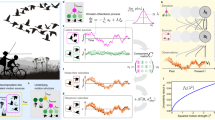Abstract
Velocity distributions are an enhanced representation of image velocity implying more velocity information than velocity vectors. Velocity distributions allow the representation of ambiguous motion information caused by the aperture problem or multiple motions at a given image region. Starting from a contrast- and brightness-invariant generative model for image formation a likelihood measure for local image velocities is proposed. These local velocities are combined into a coarse-to-fine-strategy using a pyramidal image velocity representation. On each pyramid level, the strategy calculates predictions for image formation and combines velocity distributions over scales to get a hierarchically arranged motion information with different resolution levels in velocity space. The strategy helps to overcome ambiguous motion information present at fine scales by integrating information from coarser scales. In addition, it is able to combine motion information over scales to get velocity estimates with high resolution.
Access this chapter
Tax calculation will be finalised at checkout
Purchases are for personal use only
Preview
Unable to display preview. Download preview PDF.
Similar content being viewed by others
References
Handbook of Computer Vision and Applications, chapter Bayesian Multi-Scale Differential Optical Flow. Academic Press (1999)
Bergen, J., Anandan, P., Hanna, K., Hingorani, R.: Hierarchical model-based motion estimation. In: Proc. 2nd Europ. Conf. Comput. Vis. (1992)
Simoncelli, E., Adelson, E.H., Heeger, D.J.: Probability distributions of optical flow. In: Proc. Conf. Comput. Vis. and Pat. Recogn., IEEE Computer Society, Los Alamitos (1991)
Weiss, Y., Fleet, D.J.: Velocity likelihoods in biological and machine vision. In: Probabilistic Models of the Brain: Perception and Neural Function, MIT Press, Cambridge (2002)
Wu, Q.X.: A correlation-relaxation-labeling framework for computing optical flow - template matching from a new perspective. IEEE Transactions on Pattern Analysis and Machine Intelligence 17 (1995)
Author information
Authors and Affiliations
Editor information
Editors and Affiliations
Rights and permissions
Copyright information
© 2004 Springer-Verlag Berlin Heidelberg
About this paper
Cite this paper
Eggert, J., Willert, V., Körner, E. (2004). Building a Motion Resolution Pyramid by Combining Velocity Distributions. In: Rasmussen, C.E., Bülthoff, H.H., Schölkopf, B., Giese, M.A. (eds) Pattern Recognition. DAGM 2004. Lecture Notes in Computer Science, vol 3175. Springer, Berlin, Heidelberg. https://doi.org/10.1007/978-3-540-28649-3_38
Download citation
DOI: https://doi.org/10.1007/978-3-540-28649-3_38
Publisher Name: Springer, Berlin, Heidelberg
Print ISBN: 978-3-540-22945-2
Online ISBN: 978-3-540-28649-3
eBook Packages: Springer Book Archive




